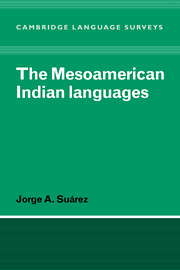Book contents
- Frontmatter
- Contents
- List of illustrations
- List of tables
- Preface
- Notational conventions
- Map 1 Present-day distribution of Mesoamerican Indian languages
- Table 1 Classification of Mesoamerican Indian languages and index to map 1
- 1 The study of Mesoamerican Indian languages
- 2 Dialects, languages and linguistic families
- 3 Phonology I
- 4 Phonology II
- 5 Morphology I
- 6 Morphology II
- 7 Syntax I
- 8 Syntax II
- 9 Preconquest literary traditions
- 10 The prehistory of Mesoamerican Indian languages
- 11 Indian languages after the conquest
- Appendix: Sources for sentences quoted in chapters 7 and 8
- References
- Language index
- Subject index
10 - The prehistory of Mesoamerican Indian languages
Published online by Cambridge University Press: 05 November 2009
- Frontmatter
- Contents
- List of illustrations
- List of tables
- Preface
- Notational conventions
- Map 1 Present-day distribution of Mesoamerican Indian languages
- Table 1 Classification of Mesoamerican Indian languages and index to map 1
- 1 The study of Mesoamerican Indian languages
- 2 Dialects, languages and linguistic families
- 3 Phonology I
- 4 Phonology II
- 5 Morphology I
- 6 Morphology II
- 7 Syntax I
- 8 Syntax II
- 9 Preconquest literary traditions
- 10 The prehistory of Mesoamerican Indian languages
- 11 Indian languages after the conquest
- Appendix: Sources for sentences quoted in chapters 7 and 8
- References
- Language index
- Subject index
Summary
The title of this chapter refers not to the information that can be obtained through reconstruction of protolanguages but to the types of correlations that can be established between linguistic groups on the one hand and documentary and archaeological data on the other. Nevertheless linguistic reconstruction will be of importance in the discussion below.
These types of correlations would ideally involve determining when and whence the languages reached their historically known locations, problems which are easier to deal with on the shallow time depth typical of dialect studies or little differentiated languages. However, our perspective is more properly the treatment of individual languages or linguistic families, so the focus of this chapter will be the broad correlations with Mesoamerican cultural history. From this perspective not much is known with reasonable certainty; neither is what is known very startling when one compares it to what can be assumed through an examination of language distribution and of linguistic genetic relationships. As some of the hypotheses advanced by scholars are important but questionable they must be approached critically.
Correlations with documentary and archaeological data
Identifications of linguistic and historical-cultural data are important for any linguistic group, but in Mesoamerica this aspect has a special significance because the area is delimited on the basis of cultural characteristics and is one of the regions in the Americas in which native cultures reached the level of complexity called civilization.
- Type
- Chapter
- Information
- The Mesoamerican Indian Languages , pp. 145 - 162Publisher: Cambridge University PressPrint publication year: 1983



